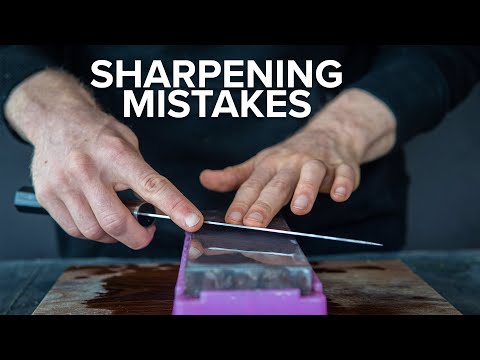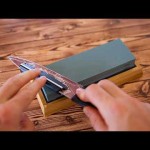
0c70960c4d9d84e1acf3a3394046c23f
Sharpening stones are an essential tool for any kitchen or workshop. They are used to sharpen knives, scissors, and other tools to keep them in top condition. With the right technique, you can easily sharpen your tools with a sharpening stone. In this article, we will provide step-by-step instructions on how to use a sharpening stone to keep your tools sharp and ready for use.
How do you use a sharpening stone for beginners
Sharpening stones are an essential tool for keeping your knives and other tools sharp. They come in a variety of shapes and sizes, and can be used to sharpen a variety of different blades. If you’re a beginner, it can be intimidating to know how to use a sharpening stone. Here are some tips to help you get started.
Choose the Right Stone
The first step in using a sharpening stone is to choose the right one for your needs. Different stones are designed for different types of blades, so make sure you select the right one for your knife or tool. Generally, a coarse stone is used for dull blades, while a fine stone is used for blades that are already sharp. You may also want to consider a combination stone, which has both coarse and fine sides.
Prepare the Stone
Before you begin sharpening, you’ll need to prepare the stone. Start by soaking it in water for about 10 minutes. This will help to remove any debris and will also help to lubricate the stone. Once the stone is soaked, use a damp cloth to wipe it down and remove any excess water.
Sharpen the Blade
Once the stone is prepared, you’re ready to begin sharpening. Start by placing the blade on the stone at a 20-degree angle. Then, using a back-and-forth motion, move the blade across the stone. Make sure to keep the angle consistent throughout the process. After a few passes, you should start to see a burr forming on the edge of the blade. This is an indication that the blade is sharpening.
Finish the Process
Once the blade is sharpened, you’ll need to finish the process. Start by flipping the blade over and repeating the sharpening process on the other side. Then, use a strop to remove any burrs and to further refine the edge. Finally, use a honing oil to lubricate the blade and to protect it from corrosion.
Conclusion
Sharpening stones are an essential tool for keeping your knives and other tools sharp. With a little practice, you can learn how to use a sharpening stone and keep your blades in top condition. Just remember to choose the right stone, prepare it properly, and use the correct technique to get the best results.
How do we properly use a sharpening stone
Sharpening stones are an essential tool for keeping your knives and other tools sharp. They come in a variety of shapes and sizes, and can be used to sharpen a variety of blades. But how do you use a sharpening stone correctly? Here are some tips to help you get the most out of your sharpening stone.
Choose the Right Stone
The first step in using a sharpening stone is to choose the right one for your needs. Different stones are designed for different types of blades, so make sure you select the right one for your blade. For example, a coarse stone is best for dull blades, while a fine stone is better for sharpening already sharp blades.
Prepare the Stone
Before you begin sharpening, you need to prepare the stone. Start by soaking the stone in water for about 10 minutes. This will help to remove any debris and will also help to lubricate the stone. Once the stone is soaked, use a damp cloth to wipe away any excess water.
Sharpen the Blade
Once the stone is prepared, you can begin sharpening the blade. Start by placing the blade on the stone at a 20-degree angle. Then, using a circular motion, move the blade across the stone. Make sure to keep the angle consistent throughout the sharpening process. After a few passes, you should start to see a burr forming on the blade. This is an indication that the blade is being sharpened.
Finish the Process
Once the blade is sharpened, you need to finish the process. Start by flipping the blade over and repeating the sharpening process on the other side. Once both sides are sharpened, use a honing steel to remove any burrs and to further refine the edge. Finally, use a damp cloth to wipe away any debris from the blade and the stone.
Conclusion
Sharpening stones are an essential tool for keeping your knives and other tools sharp. By following these steps, you can ensure that you are using your sharpening stone correctly and getting the most out of it. With a little practice, you will be able to sharpen your blades like a pro.
What are the five steps in sharpening a knife on a stone
Sharpening a knife on a stone is a great way to keep your knives in top condition. It is a simple process that requires a few basic tools and a bit of practice. Here are the five steps to sharpening a knife on a stone:
Step 1: Gather the Necessary Tools
The first step in sharpening a knife on a stone is to gather the necessary tools. You will need a sharpening stone, a honing oil, a cloth, and a sharpening guide. The sharpening stone should be a medium-grit stone, such as a 1000-grit stone. The honing oil will help to lubricate the stone and prevent it from clogging. The cloth will be used to wipe away any excess oil or debris. The sharpening guide will help to ensure that you are sharpening the knife at the correct angle.
Step 2: Prepare the Stone
The next step is to prepare the stone. Start by soaking the stone in water for about 10 minutes. This will help to remove any debris or dirt that may be on the stone. Once the stone is soaked, use the cloth to wipe away any excess water. Then, apply a few drops of honing oil to the stone and spread it evenly.
Step 3: Position the Knife
Once the stone is prepared, it is time to position the knife. Place the knife on the stone with the blade facing away from you. Make sure that the blade is positioned at the correct angle, which is usually around 20 degrees. If you are using a sharpening guide, place it on the blade and adjust it until it is at the correct angle.
Step 4: Sharpen the Knife
Now it is time to sharpen the knife. Start by applying light pressure to the blade and moving it in a circular motion across the stone. Make sure to keep the blade at the same angle throughout the process. Continue this motion for about 10-15 strokes.
Step 5: Test the Edge
The final step is to test the edge of the knife. To do this, take a piece of paper and place it on a flat surface. Then, take the knife and lightly slice the paper. If the paper slices cleanly, then the knife is sharp. If not, repeat steps 4 and 5 until the knife is sharp.
Sharpening a knife on a stone is a simple process that requires a few basic tools and a bit of practice. By following these five steps, you can keep your knives in top condition and ensure that they are always sharp.
Do you wet or dry sharpening stones
Sharpening stones are an essential tool for any woodworker or knife enthusiast. They are used to sharpen and hone blades, and can be used to maintain the sharpness of a blade over time. But when it comes to sharpening stones, there are two main methods: wet and dry. Wet sharpening is the traditional method of sharpening, and involves using a lubricant such as water or oil to help the stone cut more efficiently. This method is often preferred by experienced sharpeners, as it can produce a finer edge on the blade. Dry sharpening is a newer method, and involves using a dry stone without any lubricant. This method is often preferred by beginners, as it is easier to learn and can be done without any special equipment.
When it comes to choosing between wet and dry sharpening, it really comes down to personal preference. Both methods can produce a sharp edge on a blade, and both have their advantages and disadvantages. Wet sharpening is often preferred by experienced sharpeners, as it can produce a finer edge on the blade. However, it can be messy and requires the use of a lubricant. Dry sharpening is often preferred by beginners, as it is easier to learn and can be done without any special equipment. However, it can be more difficult to achieve a fine edge with this method.
Ultimately, the choice between wet and dry sharpening comes down to personal preference. Both methods can produce a sharp edge on a blade, and both have their advantages and disadvantages. It is important to experiment with both methods to find out which one works best for you.
We hope this article has been helpful in teaching you how to use a sharpening stone. With the right technique and practice, you’ll be able to keep your knives and tools sharp and in top condition.
Thank you for reading, and goodbye!















